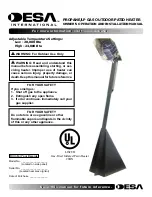
53
INSTALLATION INSTRUCTIONS
Determining the required pipe size.
The gas system is designed to operate at a certain
maximum pressure drop. A pressure drop greater
than what is permissible can cause operational issues
with the gas appliances. The National Fuel Gas Code
(NFPA 54, ANSI Z223.1 2012) allows for three pressure
drop levels, a 0.3 inch W.C., (see table 2); a 0.5 inch
W.C., (see table 3) and a 3.0 inch W.C., (see table 4)
pressure drop for natural gas. Only a 0.5 inch W.C.
pressure drop is allowable with Propane (see table
5). For Canadian installations the maximum allowable
pressure drop is 0.5 inch W.C., (see table 3).
Measure the inlet gas pressure to the system using a
manometer. For Natural Gas, if the inlet pressure is
less than 8.0 inches W.C. then use Table 2 or 3 for your
gas pipe sizing.
Table 4 can only be used if the inlet
gas pressure is 8.0 inches W.C. or greater.
Table 4
cannot be used for Canadian installations.
The gas piping system consists of a main trunk line
that runs from the meter/regulator and branch lines that
run from the trunk line to the individual appliances. A
branch may carry gas for more than one appliance.
The trunk line must be sized to carry the entire load
of all the gas appliances on the system. As with
determining the meter/regulator size, total the BTU
of all the appliances together and divide that by the
heating value of the fuel (for natural gas the average is
1,024 or 2,546 for propane). This will give you the total
cubic feet per hour of gas required for the trunk line.
Measure the total length of the line Refer to Table(s) 2,
3, or 4 and find the number closest to but higher than
the total cubic feet per hour requirement calculation.
This will tell you the minimum size that the trunk line
must be.
Each branch line must be sized to carry the load of the
appliance(s) attached to it. If more than one appliance
is on a branch total the BTU and as with the trunk line
divide that by the heating value of the fuel. Refer to
Table(s) 2, 3, or 4 and find the number closest to but
higher than the total cubic feet per hour requirement
calculation for the branch and appliance(s). This will
tell you the minimum size for that branch line and
appliance.
Final Considerations
If this water heater is replacing an existing water heater,
it is important to verify the capacity of the gas system.
Check the capacity of the meter/regulator, and verify
the pipe lengths and sizes.
An improperly sized gas system will cause operational
issues with this water heater. Other appliances on the
gas system may be affected as well.
Flexible Gas Connectors may be used however the
BTU capacity of the connector must be checked. Each
connector has a capacity label on it, verify that the
connector has a BTU capacity greater than that of the
water heater. An undersized flexible gas connector will
cause operational issues with this water heater.
Half-inch gas lines are permissible provided the gas
system meets certain requirements.
First, the gas
pressure on the system must be 8.0 inch W.C. or
greater.
Second the capacity of the pipe as outlined in
Table 4 is followed. If the existing pipes are too small
it could cause a pressure drop greater than 3.0 inch
W.C. and will cause operational issues with this water
heater as well as other gas appliances on the system.
Gas Suppl
y
Gas Supply (cont.)
Содержание RTGH-84DVLN-2
Страница 27: ...INSTALLATION INSTRUCTIONS FOR THE CONTRACTOR 27 Installation ...
Страница 58: ...58 INSTALLATION INSTRUCTIONS Wiring Diagram Electrical ...
Страница 80: ...80 NOTES ...
Страница 81: ...81 NOTES ...
Страница 82: ...82 NOTES ...
















































